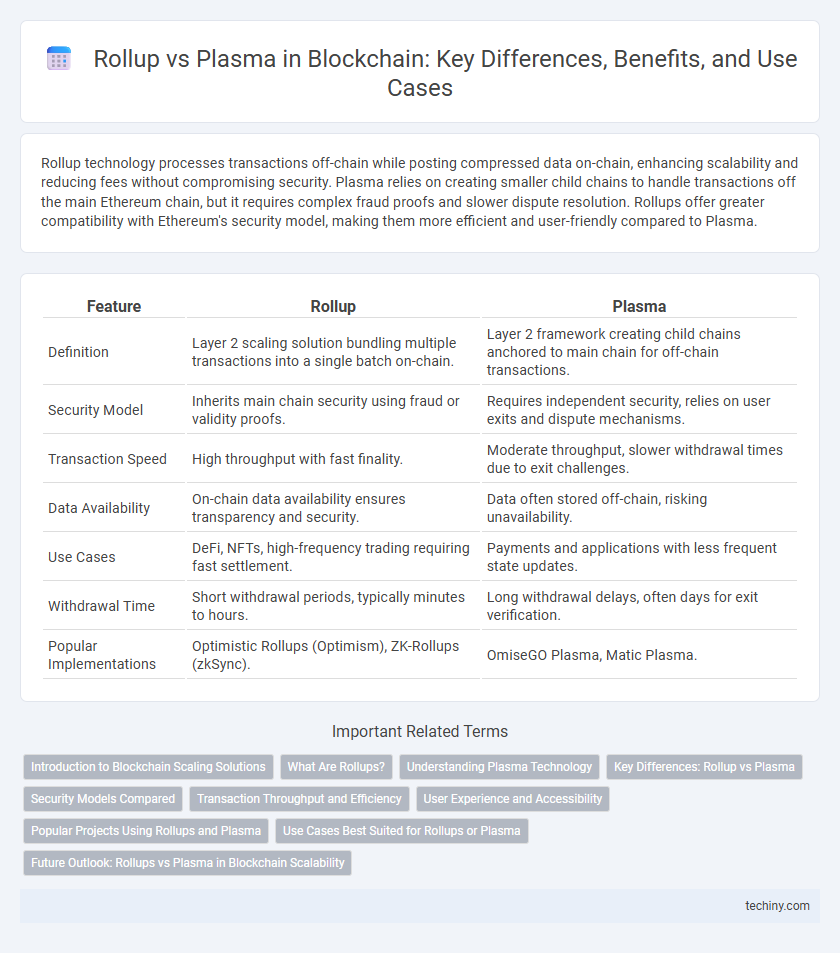Rollup technology processes transactions off-chain while posting compressed data on-chain, enhancing scalability and reducing fees without compromising security. Plasma relies on creating smaller child chains to handle transactions off the main Ethereum chain, but it requires complex fraud proofs and slower dispute resolution. Rollups offer greater compatibility with Ethereum's security model, making them more efficient and user-friendly compared to Plasma.
Table of Comparison
| Feature | Rollup | Plasma |
|---|---|---|
| Definition | Layer 2 scaling solution bundling multiple transactions into a single batch on-chain. | Layer 2 framework creating child chains anchored to main chain for off-chain transactions. |
| Security Model | Inherits main chain security using fraud or validity proofs. | Requires independent security, relies on user exits and dispute mechanisms. |
| Transaction Speed | High throughput with fast finality. | Moderate throughput, slower withdrawal times due to exit challenges. |
| Data Availability | On-chain data availability ensures transparency and security. | Data often stored off-chain, risking unavailability. |
| Use Cases | DeFi, NFTs, high-frequency trading requiring fast settlement. | Payments and applications with less frequent state updates. |
| Withdrawal Time | Short withdrawal periods, typically minutes to hours. | Long withdrawal delays, often days for exit verification. |
| Popular Implementations | Optimistic Rollups (Optimism), ZK-Rollups (zkSync). | OmiseGO Plasma, Matic Plasma. |
Introduction to Blockchain Scaling Solutions
Rollup and Plasma are prominent blockchain scaling solutions designed to increase transaction throughput and reduce fees on Ethereum. Rollups execute transactions off-chain while submitting compressed data to the mainnet, enabling higher scalability and security by leveraging Ethereum's consensus. Plasma creates child chains for batching multiple transactions off the mainnet, offering faster processing but relying more on fraud proofs and exit mechanisms for security.
What Are Rollups?
Rollups are Layer 2 scaling solutions that execute transactions off-chain while posting data on-chain to ensure security and decentralization. They improve Ethereum's throughput by bundling multiple transactions into a single proof submitted to the mainnet, reducing gas fees and congestion. Rollups come in two main types: Optimistic Rollups and Zero-Knowledge (ZK) Rollups, each using different verification methods to balance scalability and trust assumptions.
Understanding Plasma Technology
Plasma technology enhances blockchain scalability by creating smaller, autonomous child chains connected to the main Ethereum chain, enabling faster and cheaper transactions while maintaining security through periodic commitments to the root chain. Unlike Rollups, which execute transactions off-chain but submit compressed data back to the main chain for validation, Plasma relies on fraud proofs and exit mechanisms to ensure the integrity of off-chain operations. Understanding Plasma's structure highlights its focus on reducing on-chain congestion and providing scalable, secure solutions for decentralized applications.
Key Differences: Rollup vs Plasma
Rollup scales blockchain transactions by bundling multiple transfers into a single batch, reducing on-chain data while preserving security through Ethereum mainnet consensus. Plasma creates child chains that process transactions independently with periodic commitments to the main chain for security, relying more on fraud proofs and exit games. Rollups offer faster finality and better compatibility with smart contracts compared to Plasma, which is more suitable for simple transaction throughput and asset transfers.
Security Models Compared
Rollup security relies on fraud proofs and on-chain data availability, enabling validators to challenge invalid state transitions within a fixed dispute window. Plasma security depends on exit games and checkpointing with user-initiated withdrawals, which can be vulnerable to data unavailability and longer exit periods. Rollups provide enhanced security guarantees through continuous on-chain validation and immediate finality compared to Plasma's reliance on off-chain coordination and delayed withdrawal processes.
Transaction Throughput and Efficiency
Rollup technology significantly enhances transaction throughput by aggregating multiple transactions into a single proof, which reduces on-chain data load and improves scalability compared to Plasma. Plasma relies on sidechains that periodically commit summaries to the main chain, limiting throughput due to frequent exit challenges and slower finality. Rollups achieve higher efficiency with faster confirmation times and lower gas fees, making them more suitable for high-volume decentralized applications.
User Experience and Accessibility
Rollups enhance user experience by offering faster transaction finality and lower fees compared to Plasma, which often requires more complex withdrawal processes and longer delays. Rollups maintain security via on-chain data availability, making them more accessible to developers and users without compromising decentralization. Plasma's challenges with user-friendly exit strategies and limited smart contract compatibility hinder its accessibility in comparison.
Popular Projects Using Rollups and Plasma
Popular projects using rollups include Optimism and Arbitrum, which enhance Ethereum's scalability by aggregating multiple transactions off-chain and submitting a single proof on-chain. Plasma projects like OMG Network and Matic (Polygon) utilize sidechains to offload transactions from the main Ethereum chain, enabling faster and cheaper transfers. Both rollups and plasma solutions address Ethereum's scalability challenges but differ in trust models and transaction finality mechanisms.
Use Cases Best Suited for Rollups or Plasma
Rollups excel in scalability for decentralized finance (DeFi) applications and complex smart contracts by aggregating multiple transactions into a single batch on Layer 1, reducing gas fees and increasing throughput. Plasma is best suited for applications requiring fast, low-cost transactions with simpler state updates, such as micropayments and gaming, offloading work from the Ethereum mainnet while maintaining security. Rollups support richer programming environments and data availability on-chain, making them ideal for complex dApps, whereas Plasma prioritizes efficiency and security in high-frequency, smaller transaction scenarios.
Future Outlook: Rollups vs Plasma in Blockchain Scalability
Rollups demonstrate a stronger future outlook in blockchain scalability due to their ability to bundle multiple transactions off-chain while maintaining security through on-chain data availability, enabling higher throughput and lower fees. Plasma, once promising for scaling via sidechains and fraud proofs, faces challenges with data availability and exit complexity that limit its adoption in decentralized finance. As layer 2 solutions evolve, rollups like zk-Rollups and optimistic Rollups remain the preferred options for developers prioritizing scalability, security, and interoperability within Ethereum's ecosystem.
Rollup vs Plasma Infographic

 techiny.com
techiny.com